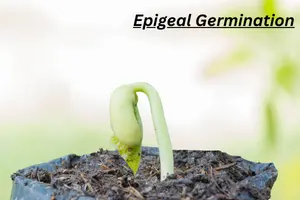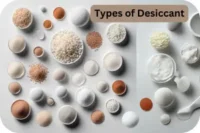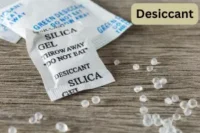What is Hypogeal Germination? Examples, Process, and Key Differences
Published: 31 Jan 2025
Greetings, Nature Explorer! 🌹
What makes some seeds grow with their first leaves hidden underground? This happens during seed hypogeal germination, where the cotyledons stay below the soil while the plant grows. Students, gardeners, and beginners can better understand how seeds sprout and adapt to their surroundings by learning about seed hypogeal germination.
As a seasoned botany expert with seven years of research experience, I’m excited to take you on a journey into the fascinating world of hypogeal germination. In this article, I’ll break down its definition, process, and examples and compare it to epigeal germination to clarify and engage you in the concept.
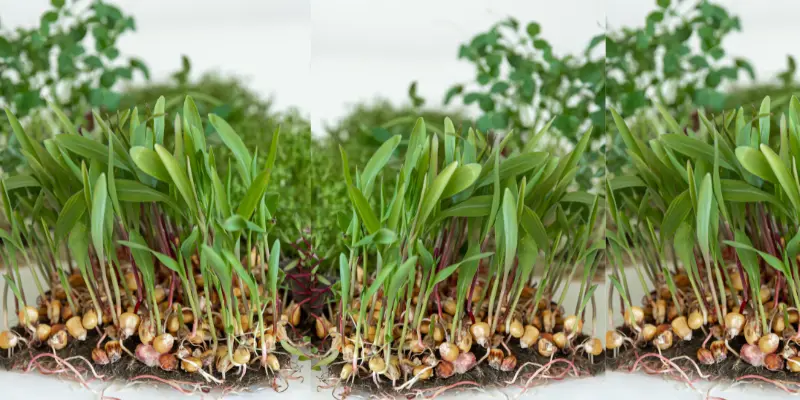
By the end of this article, you’ll understand hypogeal germination and its significance. Let’s start enriching your gardening knowledge and uncovering the secrets beneath the soil!
Understanding: What is Hypogeal Germination?
Have you ever noticed how some plants keep their early growth hidden beneath the soil? That’s the magic of hypogeal germination! This interesting process is very important for the survival of some plants, especially in tough conditions.
Let’s look closer to see what makes it different.
Definition and Key Features
The cotyledons, or seed leaves, remain below ground throughout the hypogeal germination process. It is common in plants like beans, peas, and maize. Unlike epigeal germination, where the cotyledons emerge above the soil, hypogeal germination protects the plant’s energy reserves underground.
Think of it as a plant’s way of storing its “battery pack” safely during the early stages of growth. This unique feature helps protect the seedling from harsh weather or grazing animals, giving it a better chance to thrive.
The Role of Cotyledons in Hypogeal Germination
- In hypogeal germination, the cotyledons act like a hidden storage unit, staying beneath the soil and providing nutrients to the growing plant. This contrasts with epigeal germination, where cotyledons rise above the soil and perform photosynthesis.
- For monocots like maize, the single cotyledon is vital in transferring stored nutrients to the seedling.
- The two cotyledons remain underground in dicots like beans, acting as a food reservoir.
- From my gardening experience, I’ve noticed that plants using hypogeal germination tend to handle sudden temperature changes better, thanks to their underground reserves. It’s a clever survival mechanism that nature has perfected!
How Does Hypogeal Germination Work?
Understanding how hypogeal germination works can feel like unlocking the secret recipe for hidden plant growth. This unique process focuses on underground strength before the plant emerges above ground.
Let’s move forward and discover the ideal conditions for this fascinating process.
Step-by-Step Process
- Seed Absorption: The process begins when the seed absorbs water from the soil, triggering metabolic activity. This step is like waking up after a long nap—the seed activates its stored energy.
- Radicle Emergence: The radicle, or the first root, pushes out from the seed to anchor the plant and absorb nutrients. Think of it as the seed setting its foundation underground.
- Plumule Growth: The plumule, which develops into the shoot, grows upward while the cotyledons stay safely buried beneath the soil. This ensures protection from environmental stress.
- Shoot Emergence: The shoot finally breaks through the soil surface, ready to absorb sunlight and continue its growth.
When I first grew beans in my garden, I was amazed by how the cotyledons remained hidden beneath the soil, like a treasure chest safeguarding essential nutrients for the seedling.
Environmental Conditions for Hypogeal Germination
For hypogeal germination to occur successfully, the seed needs the right conditions.
- Soil Type: Loamy soil works best as it provides proper aeration and drainage while retaining essential nutrients.
- Moisture: Consistent moisture is crucial for activating germination, but overwatering can lead to rot. A well-drained soil ensures a balanced environment.
- Temperature: Moderate temperatures, typically between 20–30°C (68–86°F), are ideal for most hypogeal seeds. Extreme temperatures can delay or hinder growth.
When I planted maize in my backyard, I noticed the importance of maintaining soil moisture. If the soil were too dry, the seeds wouldn’t sprout, and if it were too wet, they wouldn’t grow properly. Finding the perfect balance made all the difference.
Following these steps and providing the right conditions can help seeds with hypogeal germination grow successfully in your garden.
Examples of Plants with Hypogeal Germination
Some plants follow the hypogeal germination process, where their cotyledons stay safely below the soil. This adaptation protects vital energy reserves and helps plants grow in challenging conditions.
Let’s explore some common examples and why this process is essential for agriculture.
Common Examples in Nature
Below is a table highlighting some common plants that use hypogeal germination and their unique characteristics.
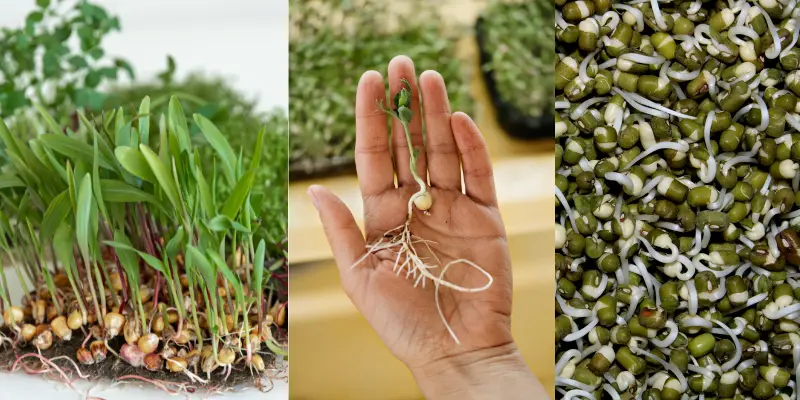
I’ve also shared personal experiences to make these examples more relatable.
| Plant | Unique Traits | Personal Experience |
| Peas | Cotyledons stay underground, storing energy for steady growth in cool climates. | I’ve seen peas thrive in my garden during early spring when the weather is still unpredictable. |
| Beans | Use hypogeal germination to protect their seed reserves from pests and harsh conditions. | In my experience, beans grow well even in compact soil, showing how this method aids strength. |
| Maize | Anchors itself firmly in the soil before sprouting, ensuring stability during early development. | Maize in my garden remained stable even during heavy rainstorms, showcasing the benefits of this process. |
Importance of Hypogeal Germination in Agriculture
- Hypogeal germination is important in farming, particularly for crops in areas with hard weather or soil changes.
- By keeping their cotyledons underground, these plants can resist damage from pests and environmental stress.
- This method also makes certain crops, like maize, more reliable and productive in large-scale farming.
- Learning about this process has helped me choose strong plants for my yard, ensuring a good harvest every year.
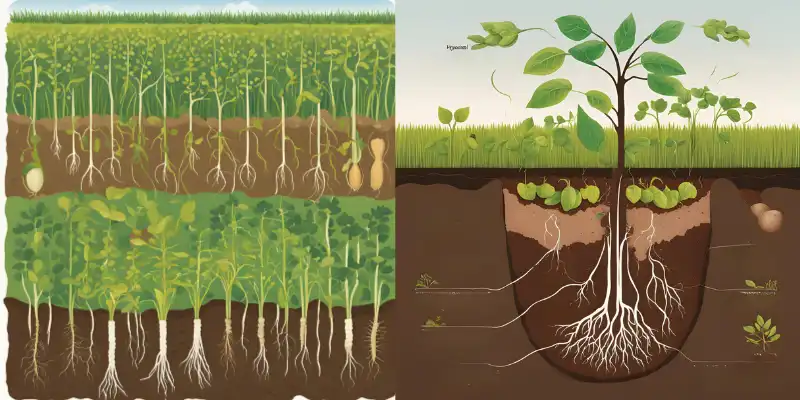
Advantages and Disadvantages of Hypogeal Germination
Hypogeal germination has its strengths and weaknesses, making it an important process for gardeners and farmers to understand. Let’s explore how it benefits plants in specific scenarios while considering its limitations.
Think of it like a toolbox—while it’s perfect for certain tasks, it might not work as well for others.
| Advantages | Disadvantages |
| Protects Vital Energy Reserves: Cotyledons stay underground, shielding them from pests, frost, and strong winds. | Slower Initial Growth: Plants take longer to emerge above ground, delaying visible progress. |
| Ensures Stability: Plants like maize develop strong roots, anchoring them firmly in the soil. | Limited Energy Supply: Growth can be slowed if the soil is compacted or lacks nutrients. |
| Adapts to Harsh Environments: Thrives in challenging conditions like poor soil or extreme weather. | Less Visible Growth Indicators: Beginners might find it harder to monitor early development. |
Personal Note: I’ve always admired how plants with hypogeal germination, like beans, can weather unpredictable conditions, much like a tree standing firm during a storm.
However, I’ve learned that patience is key when waiting for them to sprout, especially if the soil isn’t perfect, like waiting for a flower to bloom in less-than-ideal conditions.
| Fresh and Unique Facts |
|---|
|
Conclusion
So, guys, it’s time to wrap up. In this article, we’ve covered seed hypogeal germination in detail. From exploring examples like peas and maize to discussing their importance in agriculture, you now understand the process.
If you’re a gardener or farmer, I highly recommend considering hypogeal germination for your crops—it’s a fantastic way to enhance their growth and protect them from environmental stress.
If you’re ready to learn more about plant growth, remember to explore other articles on our site!
Frequently Asked Questions
These FAQs provide clear, beginner-friendly guidance to help readers better understand seed hypogeal germination:
Hypogeal germination occurs when the seed’s cotyledons (first leaves) remain underground as the plant grows. This happens in certain plants, such as beans and maize. It helps protect the seed’s energy reserves and ensures steady growth.
Seeds undergo hypogeal germination to protect their cotyledons from environmental factors like pests, frost, or wind. Keeping the cotyledons underground ensures that the plant has enough nutrients to grow. This adaptation is beneficial for plants in harsh conditions.
Beans, peas, and maize are common plants that use hypogeal germination. This process helps these plants survive in challenging environments, making it a great adaptation for many crops.
Hypogeal germination protects the seed’s energy stores underground, prevents damage from external factors, and ensures better stability for the young plant. Plants like maize grow strong roots that keep them anchored. These benefits are essential in farming and gardening.
While hypogeal germination plants can adapt to various conditions, they grow best in loose, nutrient-rich soil. Compacted or poor soil may hinder their early development. Improving soil quality can enhance the chances of successful germination.
Yes, hypogeal germination is vital for many crops, including maize and beans. It helps crops resist environmental stresses, like strong winds or cold temperatures. Understanding this process can help farmers select the best crops for their region’s climate.
| Reference Source |
|---|
Temperature Requirements for Seed Germination and Plant Growth |

- Be Respectful
- Stay Relevant
- Stay Positive
- True Feedback
- Encourage Discussion
- Avoid Spamming
- No Fake News
- Don't Copy-Paste
- No Personal Attacks



- Be Respectful
- Stay Relevant
- Stay Positive
- True Feedback
- Encourage Discussion
- Avoid Spamming
- No Fake News
- Don't Copy-Paste
- No Personal Attacks

